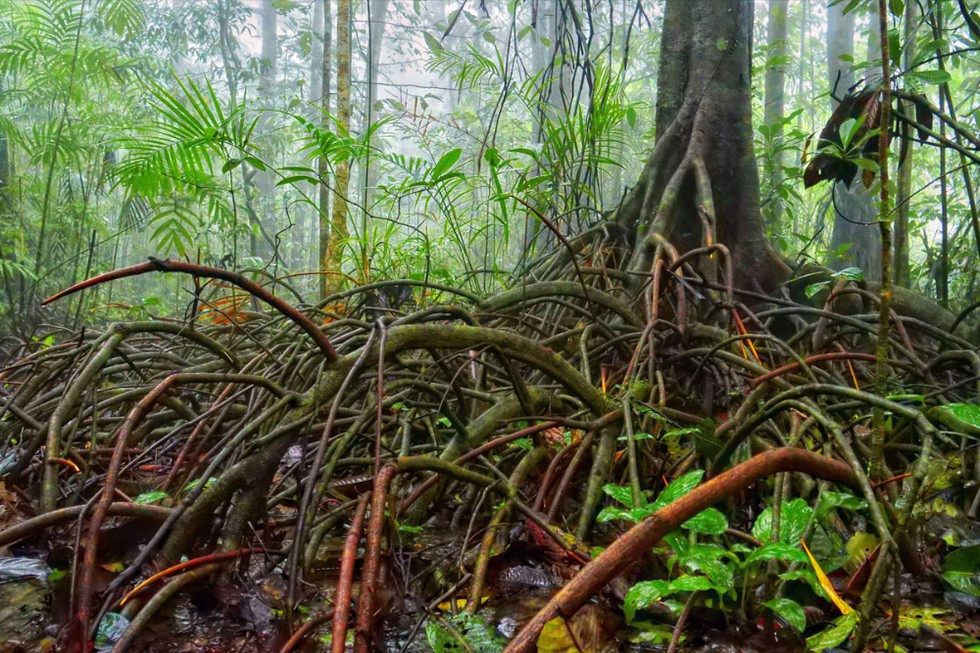
About Myristica Swamps:
- These are freshwater swamps dominated by evergreen trees belonging to the Myristicaceae family.
- They are also denoted as living fossils due to the primitive nature of Myristica plants.
- With an evolutionary origin of about 140 million years, the swamps are valuable for evolutionary studies.
- These forests are characterized by trees with large protruding roots jutting out of waterlogged soil, which remains inundated throughout the year.
- Geographical distribution:In India, these unique habitats occur in the Western Ghats and a smaller distribution exists in the Andaman and Nicobar Islands and Meghalaya.
- Historically, they formed a large hydrological network all along the Western Ghats.
- Climatic conditions: The formation of these swamps is dependent on abiotic conditions like the shape of the valley between the forested hills, the amount of rainfall a place receives (with an average of 3000 mm) and water availability throughout the year.
- Typically, Myristica swamps are seen next to rivers and help in retaining water and act as a sponge, ensuring perennial water availability.
- These forests have higher ability to sequester carbon than non-swampy forests.
- These swamps are home to many vertebrate and invertebrate faunal species. This is due to stable macroecological conditions like high humidity, moderate temperature, and macrohabitat availability.
- One example is the Myristica Swamp Treefrog (Mercurana myristicapalustris), only reported from a few pockets of the Shendurney and Peppara Wildlife Sanctuaries in Kerala.
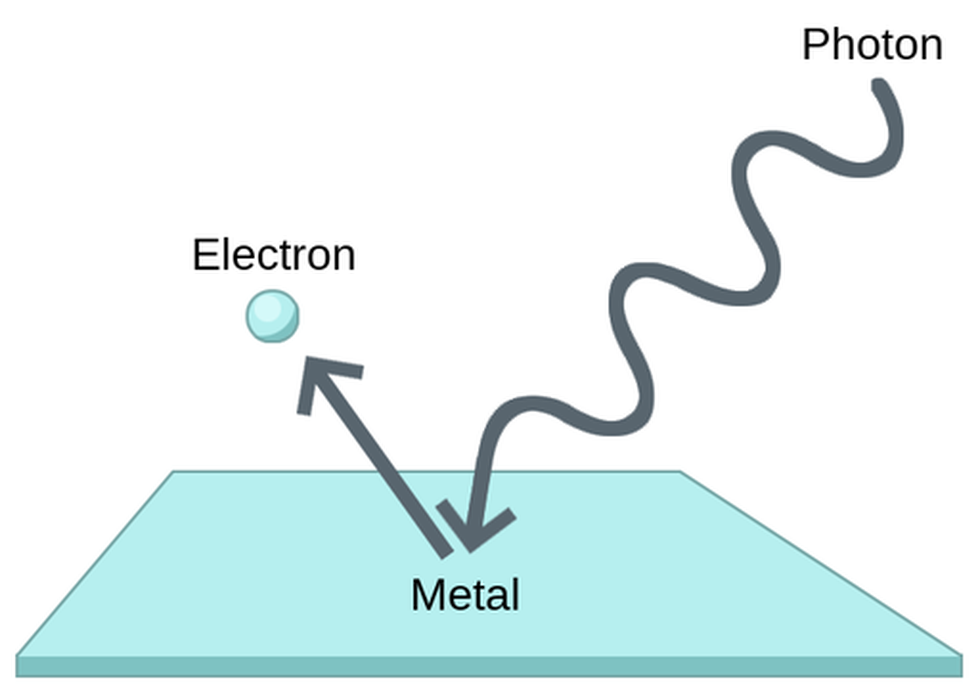
About Photoelectric Effect:
- It is a phenomenon where electrons are emitted from a material’s surface when it is exposed to light of sufficient frequency.
- When light photons hit the surface of a material, usually a metal, they transfer their energy to the electrons. If this energy is sufficient, the electrons are emitted from the material.
- The energy must be greater than the electron’s binding energy, known as the work function, for the electron to be ejected from the material’s surface.
- The excess energy from the photon, after overcoming the work function, is converted into the kinetic energy of the ejected electron.
- A material that can exhibit this phenomenon is said to be photoemissive, and the ejected electrons are called Photoelectrons.
- The effect was discovered in 1887 by the German physicistHeinrich Rudolf Hertz.
- The photoelectric effect is pivotal in understanding the quantum nature of light, as it reveals that light possesses both wave-like and particle-like properties.
- This duality is a cornerstone of quantum mechanics, illustrating how light can exhibit behaviors characteristic of both waves and discrete particles.
- The discovery and understanding of the photoelectric effect have profound implications in various scientific and technological fields, including the development of photovoltaic cells and advanced imaging technologies.
3. Key Facts about Paraguay River
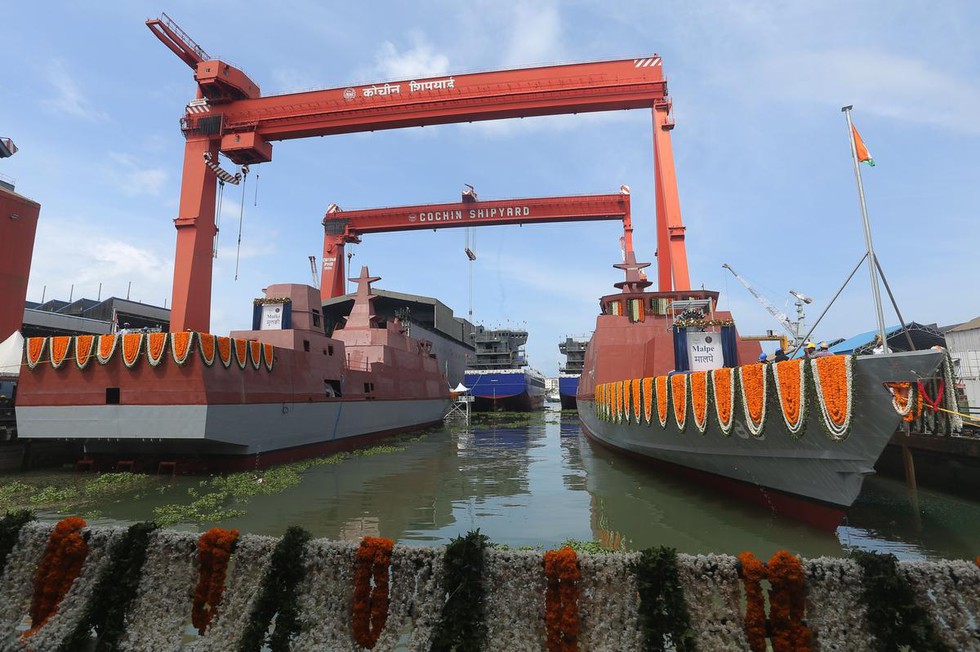
About Paraguay River:
- It is the fifth largest river in South America.
- It runs over a course of approximately 1,584 miles (2,549 kilometers) from its headwaters in the Brazilian state of Mato Grosso (within the Brazilian Highlands) to its confluence with the Paraná River, of which it is the main tributary, just north of Corrientes, Argentina.
- It runs through Brazil, Bolivia, Paraguay and Argentina.
- The river serves as a natural boundary, particularly between Paraguay and Brazil and between Paraguay and Argentina.
- The Pantanal, one of the most pristine and biologically rich environments on the planet, is contained within the Upper Paraguay River Basin.
- Pantanal is the world’s largest tropical wetland.
- The Paraguay, along with the Paraná and Uruguay Rivers, form the second most important drainage system in the world, which covers approximately 1.6 million square miles.
- These empty into the Rio de la Plata estuary at a rate of 2.8 million cubic feet of water per second, an outflow second only to that of the Amazon River. Thereafter, the rivers empty into the Atlantic Ocean.
4. INS Malpe and INS Mulki

About INS Malpe and INS Mulki:
- They are two indigenously designed and constructed Anti-Submarine Warfare Shallow Watercrafts (ASWCWC) built for the Indian Navy.
- This is the fourth and fifth ASWCWC being built for the Navy.
- They are constructed by the Cochin Shipyard Limited (CSL).
- These vessels, known as the Mahe Class, will replace the current Abhay Class ASW Corvettes in the Indian Navy.
- Features:
- The vessels are capable of conducting anti-submarine operations in coastal waters, low-intensity maritime and mine-laying operations, besides sub-surface surveillance and search and rescue operations.
- The vessels are 78.0 m long and 11.36 m wide, with a draught of about 2.7 m.
- The displacement is about 900 tonnes, with a maximum speed of 25 knots and endurance of 1,800 nautical miles.
- The ships are designed to fit indigenously developed, state-of-the-art SONARS for underwater surveillance.
- They are equipped with light-weight torpedoes, anti-submarine warfare rockets, a close-in weapon system and remote-controlled guns.
5. Key Facts about Pahadi Korwa Tribe

About Pahadi Korwa Tribe:
- It is a Particularly Vulnerable Tribal Group (PVTG) of Chhattisgarh.
- They belong to the Chhota Nagpur area of Central India.
- They are primarily found in Korba and Jashpur districts of Chhattisgarh.
- A small population lives in Jharkhand and Uttar Pradesh.
- Language:
- The mother tongue of Korwa people is the Korwa language. Alternative names for this language include Ernga and Singli.
- Korwa people call their language their Bhashi, which means local language.
- This language belongs to the Munda branch of the Austroasiatic language family.
- Korwa people also speak Sadri and Chhattisgarhi as their second language.
- Economy:
- They largely depend on small-scale farming, fishing, hunting, and foraging forest produce.
- They mainly practice a form of subsistence agriculture called jhoonga kheti. This agricultural technique includes clearing of the forest in order to harvest lentils and other crops.
- Most of the families of Pahadi Korwa follow the nuclear family structure.
- This tribe lives away from modernity by building houses near the forests with very limited resources.
- But when any member of their family dies in their house. Then they abandon that house and migrate from there to some other place and build home again.
- The Korwa tribe has its own panchayat. Justice is administered to lawbreakers in a group meeting, in accordance with societal conventions.
- Religion:
- The religious practices are restricted to ancestral worship and to the worship of a handful of gods and deities.
- The significant gods are Sigri Dev, Gauria Dev, Mahadev or Lord Shiva, and Parvati. Khudia Rani is the supreme god of this community.
Key Facts about Pradhan Mantri Janjati Adivasi Nyaya Maha Abhiyan (PM JANMAN):
- It aims to improve the socio-economic status of PVTGs by bridging gaps in health, education and livelihoods; by improving basic infrastructure in Particularly Vulnerable Tribal Group (PVTG) communities, habitations and families aligning with existing schemes of Nine Ministries/Departments.
- PM-JANMAN focuses on 11 critical interventions for PVTGs.
- The scheme aims to provide crucial interventions such as permanent housing, road connectivity, piped water supply, mobile medical units, hostel construction, ‘Anganwadi’ facilities and skill development centres etc.
- Other than the 11 critical interventions, the following interventions of other ministries will be part of the Mission:
- The Ministry of Ayush will set up an Ayush Wellness Centre as per existing norms, and Ayush facilities will be extended to PVTG habitations through Mobile Medical Units.
- The Ministry of Skill Development and Entrepreneurship will facilitate skill and vocational training in PVTG habitations, multipurpose centres and hostels as per the suitable skills of these communities.
- The total outlay for the PM-JANMAN has been pegged at Rs 24,104 crore, of which the central share will be Rs 15,336 crore and the states will contribute Rs 8,768 crore.
6. Presbyopia

About Presbyopia:
- It is an age-related condition in which the eyes gradually lose the ability to focus on nearby objects.
- People usually start to develop presbyopia at around the age of 40. According to doctors, spectacles are one of the most effective ways to manage the condition.
- How does PresVu work?
- The active ingredient — chemical compounds in medicines that have an effect on the body — in PresVu is Pilocarpine.
- The compound contracts the iris muscles, which control the size of the pupil and help humans see things clearly, thereby enabling one’s eyes to focus better on nearby objects.
- PresVu uses “advanced dynamic buffer technology” — essentially, a base solution — to adapt to the pH level (a scale used to measure how acidic or basic a substance is) of tears.
- This ensures that the eye drop has “consistent efficacy and safety for extended use, keeping in mind that such drops will be used for years at a stretch”.
- PresVu is a prescription-only medicine and its impact is unlikely to last beyond four to six hours. It should not be used by people who have inflammation of the iris.
- Regular use of PresVu may lead to itching and redness, eyebrow pain, and muscle spasms in the eyes.
7. Yellow Food Dye

About Yellow Food Dye:
- It is also known as tartrazine and is a synthetic food colorant classified as an azo dye.
- It is lemon yellow in color and water-soluble.
- It is used in many dairy products, beverages, desserts and confectionaries etc.
Highlight of the study
- This dye absorbs blue light strongly, which yields its characteristic orange-to-red color when dissolved in water.
- This happens because the blue part of the light is absorbed, leaving only the orange-to-red part visible.
- Normally, biological tissues scatter light due to their diverse composition of proteins, fats, and liquids.
- Researchers found that a concentrated tartrazine solution can match the refractive indices of these components, reducing light scattering and allowing light to pass through. This makes the skin appear transparent.
- When applied, tartrazine absorbs certain wavelengths of light, especially red light, changing how light interacts with the tissue.
- This effect enabled the researchers to see blood vessels, internal organs, and muscle contractions in real time.
Potential Applications
- This technique could simplify blood draws, improve laser tattoo removal and aid in early cancer detection.
8. Elongated Tortoise

About Elongated Tortoise:
- Appearance: The tortoise is medium-sized with a yellowish brown or olive shell and distinct black blotches at the centre of each scute.
- Unique features:
- The tortoise has on its nostril a pink ring, which appears in the breeding season. Mature individuals of both sexes develop a distinct pinkish colouration surrounding the nostrils and eyes during the season.
- Distribution:
- The tortoise, is found in the Sal deciduous and hilly evergreen forests.
- It is distributed across Southeast Asia from northern India, Nepal, Bhutan and Bangladesh in the west, eastward through Myanmar, Thailand and all of Indo-China, north to Guangxi Province of China and south to Peninsular Malaysia.
- A disjunct tortoise population exists in the Chota Nagpur plateau in eastern India. It also inhabits lowlands and foothills of up to 1,000 m above sea level.
- Conservation status
- IUCN: Critically Endangered
- CITES: Appendix II
9. Nilgiri Mountain Railway
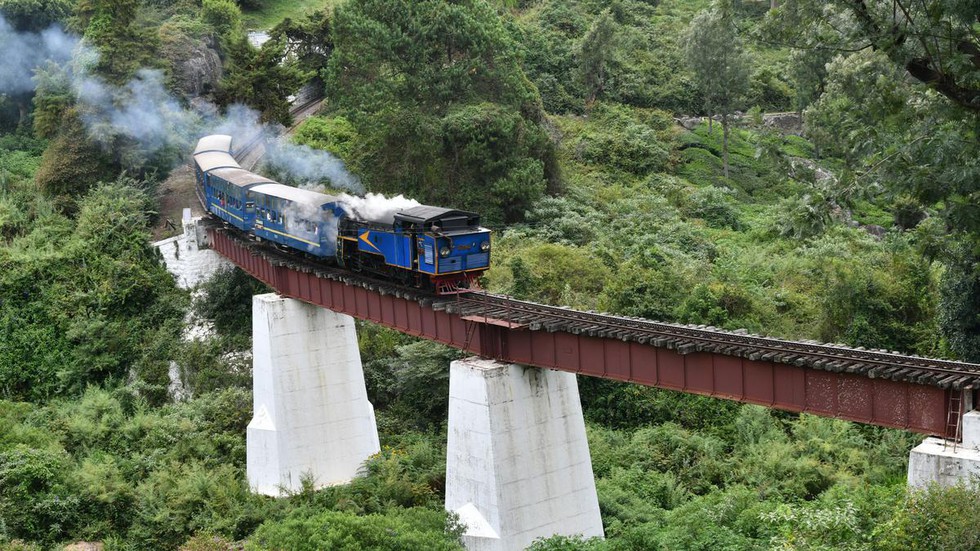
About Nilgiri Mountain Railway:
- Location: The Railway line from Mettupalaiyam to Ooty is 45.88 km. long and lies partly in the Coimbatore District and partly in Nilgiri District of Tamilnadu, on the eastern slopes of the Western Ghats.
- It is fondly called the Ooty toy train of the Nilgiris Railway Company, first chugged up the hills on June 15, 1899.
- History:
- It was in 1854, that the first plans were made to build a mountain Railway from Mettupalaiyam to the Nilgiri Hills.
- But it took the decision-makers 45 years to cut through the bureaucratic red tape and complete the construction and installation of the line.
- The line was completed and opened for traffic in June 1899.
- It was operated first by the Madras Railway under an agreement with the Government.
- In 2005, the Nilgiri Mountain Railway was recognized as a UNESCO World Heritage Site, joining the ranks of India’s other famous mountain railways, such as the Darjeeling Himalayan Railway and the Kalka-Shimla Railway.
- This designation underscores the railway’s cultural and historical importance, as well as its role in showcasing India’s rich heritage.
10. District Agro-Meteorology Units
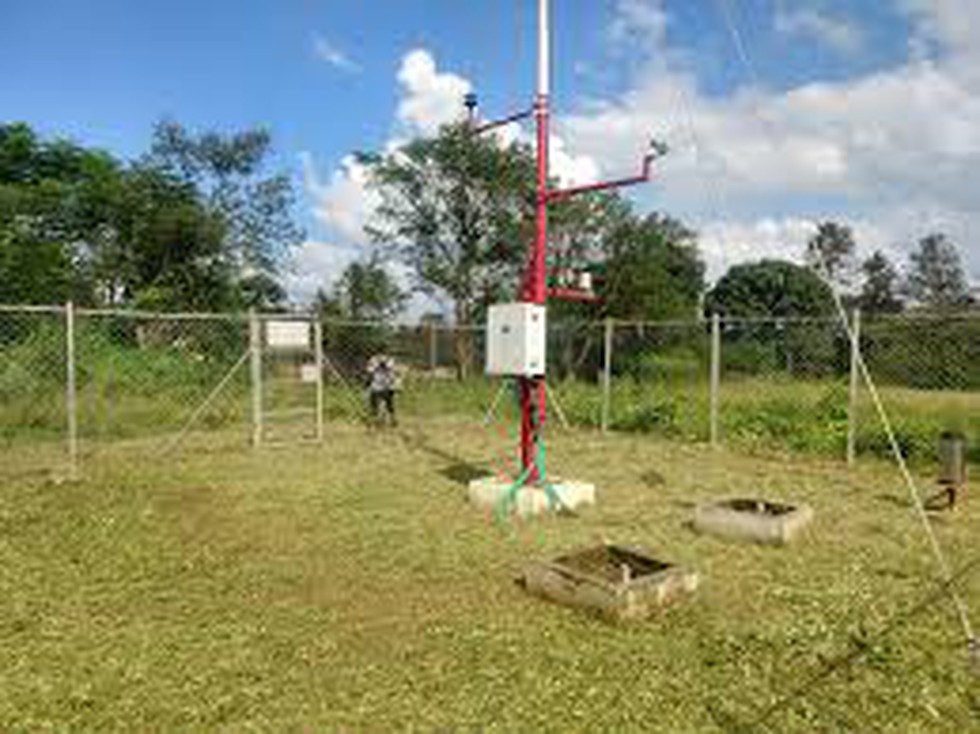
About District Agro-Meteorology Units:
- These were established by the India Meteorological Department (IMD) in 2018 in collaboration with the Indian Council of Agricultural Research (ICAR).
- Aim: The aim was to use weather data to prepare and disseminate sub-district-level agricultural advisories.
- Working
- The DAMUs were located within Krishi Vigyan Kendras (KVKs).
- Scientists and researchers trained in meteorology and agriculture were recruited as DAMU staff.
- They used weather data provided by the IMD like rainfall, temperature and wind speeds to prepare agricultural advisories related to sowing and harvesting, usage of fertilizers and pesticides, irrigation, etc.
- These advisories were sent to millions of farmers across the country free of cost in local languages twice a week.
- They were shared via text messages, WhatsApp groups, newspapers and also through in-person communication from DAMU staff and KVK officers.
- These advisories provided weather information in advance, they helped farmers plan activities like irrigation.
- They also served as early warnings for extreme events like droughts and heavy rainfall. Many studies conducted over the years have stressed the benefits of agro-met advisories.


























































































































































.png)
.png)
.png)
.png)
.png)


.png)
.png)
.png)





.png)
.png)






.png)
.png)
.png)
.png)
.png)
.png)
.png)
.png)
.png)

.png)







.png)
.png)


.png)
.png)
.png)


.png)

.png)
.png)





.jpg)

.png)
.png)


.png)

.png)
.png)
.png)

.jpg)

.jpg)


.png)

.png)
.png)
.png)
.png)
.png)
.png)
.png)
.png)
.png)
.png)




.png)

.png)





.png)
.png)
.png)
.png)
.png)
.png)
.png)
.png)
.png)
.png)
.jpg)
.jpg)

.png)
.png)
.png)
.png)
.png)
.png)
.png)
.png)
.png)
.png)
.png)
.png)
.png)
.png)
.png)
.png)
.png)
.png)
.png)
.png)
.png)
.png)



.png)
.png)

.jpg)
.jpg)


.jpg)
.jpg)
.jpg)
.jpg)
.jpg)

.jpg)








.jpg)
.jpg)
.jpg)
.jpg)
.jpg)

















.jpg)
.jpg)







.jpg)


















.jpg)
.jpg)






























































































.jpg)
.jpg)


























.jpg)

.jpg)










.jpg)








.jpg)




.jpg)










.jpg)


















.jpg)












































.jpg)














.jpg)
.jpg)
.jpg)





.jpg)

.jpg)
.jpg)





































































.jpg)


































.jpg)
.jpg)
















































.jpg)












.jpg)


.jpg)




.jpg)
.jpg)
.jpg)

.jpg)
.jpg)
.jpg)
.jpg)

.jpg)
.jpg)
.jpg)

.jpg)
.jpg)
.jpg)
.jpg)
.jpg)
.jpg)
.jpg)
.jpg)

.jpg)


.jpg)
.jpg)
.jpg)
.jpg)
.jpg)
.jpg)
.jpg)
.jpg)
.jpg)
.jpg)











.jpg)
.jpg)





.jpg)
.jpg)
.jpg)
























.jpg)
























.jpg)









.jpg)
.jpg)







.jpg)
.jpg)









































.jpg)
.jpg)
.jpg)
.jpg)
.jpg)

.jpg)
.jpg)
.jpg)
.jpg)
.jpg)


.jpg)
.jpg)
.jpg)
.jpg)
.jpg)

.jpg)
.jpg)
.jpg)
.jpg)
.jpg)
.jpg)
.jpg)
.jpg)
.jpg)
.jpg)
.png)

.png)
.png)

.png)
.png)
.png)
.png)


.jpg)
.jpg)

.jpg)
.jpg)
.jpg)

.png)
.png)
.png)
.png)
.png)
.png)
.png)

.png)
.png)
.png)
.png)
.png)
.png)
.png)
.png)
.png)
.png)





































































-min.png)



.png)




.png)








































